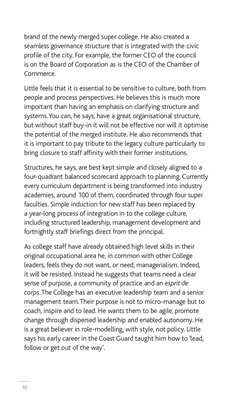
30
brand of the newly merged super college. He also created a
seamless governance structure that is integrated with the civic
profile of the city. For example, the former CEO of the council
is on the Board of Corporation as is the CEO of the Chamber of
Commerce.
Little feels that it is essential to be sensitive to culture, both from
people and process perspectives. He believes this is much more
important than having an emphasis on clarifying structure and
systems. You can, he says, have a great organisational structure,
but without staff buy-in it will not be effective nor will it optimise
the potential of the merged institute. He also recommends that
it is important to pay tribute to the legacy culture particularly to
bring closure to staff affinity with their former institutions.
Structures, he says, are best kept simple and closely aligned to a
four-quadrant balanced scorecard approach to planning. Currently
every curriculum department is being transformed into industry
academies, around 100 of them, coordinated through four super
faculties. Simple induction for new staff has been replaced by
a year-long process of integration in to the college culture,
including structured leadership, management development and
fortnightly staff briefings direct from the principal.
As college staff have already obtained high level skills in their
original occupational area he, in common with other College
leaders, feels they do not want, or need, managerialism. Indeed,
it will be resisted. Instead he suggests that teams need a clear
sense of purpose, a community of practice and an esprit de
corps. The College has an executive leadership team and a senior
management team. Their purpose is not to micro-manage but to
coach, inspire and to lead. He wants them to be agile, promote
change through dispersed leadership and enabled autonomy. He
is a great believer in role-modelling, with style, not policy. Little
says his early career in the Coast Guard taught him how to 'lead,
follow or get out of the way'.